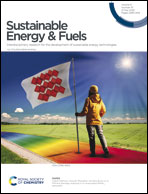Realizing high-rate aqueous zinc-ion batteries using organic cathode materials containing electron-withdrawing groups†
Abstract
Aqueous zinc batteries are among the most competitive energy storage devices for future wearable electronics and large-scale energy storage because of their intrinsic safety and low cost. To obtain environmentally friendly organic cathode materials with high-rate performance, herein, hexafluorohexaazatrinaphthylene (HFHATN) was synthesized by introducing a strong electron-withdrawing group, F atom to hexaazatrinaphthylene (HATN), and investigated as the cathode material of zinc batteries for the first time. With the introduction of F atom, the HFHATN electrode exhibited high-rate performance along with discharge specific capacities of 476 mA h g−1 at 0.04 A g−1 and 172 mA h g−1 at 20 A g−1, as well as long-life cycle stability (over 1000 cycles) with fast kinetics. Various ex situ studies and density functional theory calculations revealed that Zn2+ and H+ ions may all participate in the discharging–charging process of the organic cathode. In addition, the fabricated belt-shaped aqueous Zn//HFHATN batteries have both high volumetric energy density (8.2 mW h cm−3) and excellent flexibility and high stability, showing its application prospects in wearable electronics.



 Please wait while we load your content...
Please wait while we load your content...